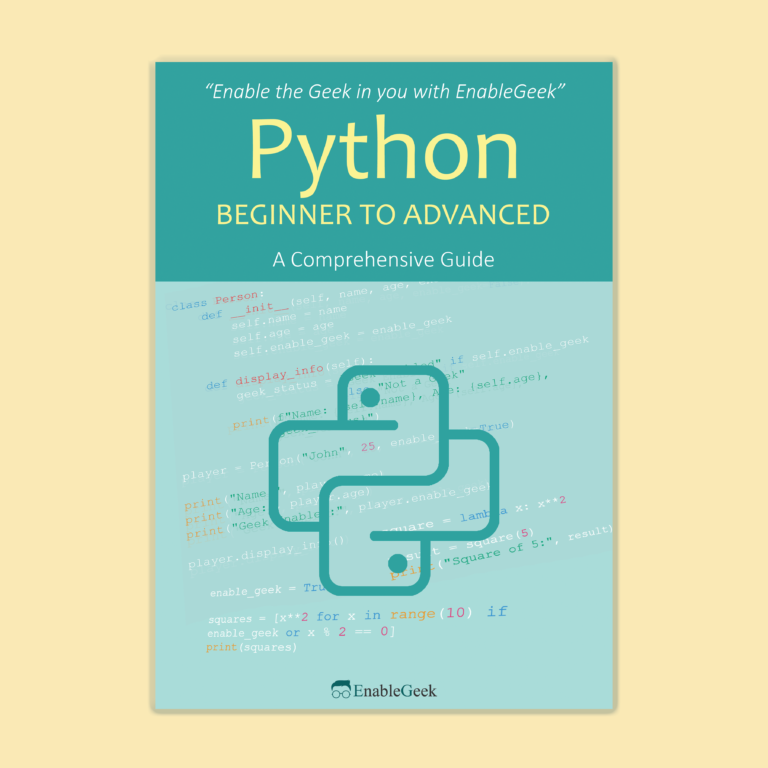About NaN value
NaN stands for “Not a Number”. It is a special floating-point value that is used to represent the result of an undefined or unrepresentable mathematical operation.
NaN can arise in several ways, such as when dividing a number by zero, taking the square root of a negative number, or performing operations with infinity.
NaN is often used to indicate missing or undefined data in data analysis and scientific computing. In Python, NaN is represented by the special value ‘float('nan')‘ or ‘numpy.nan‘ when using the NumPy library.
It’s important to note that NaN values do not compare equal to any other value, including other NaN values. This means that a comparison such as ‘NaN == NaN‘ will always return ‘False‘. In Python, you can use the ‘math.isnan()‘ function to check whether a value is NaN or not.
Discover more Python tips and elevate your coding skills with our comprehensive guide, “Python Beginner to Advanced.” Whether you’re a beginner or an experienced developer, this book covers everything from basic concepts to advanced techniques. And if you’re interested in expanding your programming collection, don’t miss out on our “Java Beginner to Advanced” guide as well!
Check for NaN Values in Python
In Python, you can check for NaN values using the math.isnan() function or the NumPy library’s ‘numpy.isnan()‘ function. Here are some examples:
import math
import numpy as np
# Check if a value is NaN using math.isnan()
x = float('nan')
if math.isnan(x):
print('x is NaN')
else:
print('x is not NaN')
# Check if a value is NaN using numpy.isnan()
arr = np.array([1.0, float('nan'), 2.0, np.nan])
nan_indices = np.isnan(arr)
print(nan_indices)
In the first example, math.isnan() is used to check whether the value of ‘x‘ is NaN. If ‘x‘ is NaN, the function returns ‘True‘ and the program prints 'x is NaN'. Otherwise, the function returns ‘False” and the program prints 'x is not NaN'.
In the second example, a NumPy array containing some NaN values is created. The np.isnan() function is used to check which elements of the array are NaN, returning a boolean array where ‘True‘ indicates a NaN value. This boolean array can be used to mask or filter the original array to work with only the non-NaN values.
Note that the ‘==‘ operator should not be used to check for NaN values, as it will always return ‘False‘ even when comparing NaN to itself.
Handling NaN in Data Analysi
In the realm of data analysis, the presence of NaN (Not a Number) values poses a significant challenge. These missing or undefined values, if not handled judiciously, can cast shadows over the integrity and reliability of analyses. Common challenges emerge as data scientists navigate the intricate waters of NaN, seeking ways to mitigate its impact on statistical insights, visualizations, and algorithmic models.
One of the primary challenges lies in data integrity. NaN values scattered throughout a dataset can act as silent saboteurs, subtly compromising the reliability of analyses. Identifying and addressing these gaps in data become paramount to fortify the foundation upon which subsequent insights are built.
Moreover, the specter of statistical bias looms large. NaN values, if not properly handled, can skew statistical measures such as mean, variance, and correlations. The consequences of such biases can ripple through analyses, potentially leading to flawed interpretations of data patterns and trends.
Visualizations, as powerful storytelling tools in data analysis, face their own set of challenges in the presence of NaN. Gaps in data, if not appropriately managed, can distort visual representations, rendering them misleading. Tackling these visualization challenges involves crafting visual narratives that transparently reflect the true nature of the underlying data.
Algorithmic models, the backbone of many data analyses, confront hurdles when NaN values are in play. Certain machine learning algorithms struggle with missing data, raising the stakes in terms of model accuracy and performance. Successfully addressing algorithmic impact requires strategic handling of NaN values to ensure the robustness of models.
However, the journey through NaN-laden datasets is not without its nuances. The decision to handle NaN often involves striking a balance between data cleaning overhead and information preservation. Deleting rows or columns with NaN values might streamline the process, but at the cost of potential data loss.
In the arsenal of techniques available for handling NaN values, one approach involves dropping NaN values selectively. This method, while effective, necessitates a careful consideration of the trade-offs involved, weighing the benefits against the potential loss of valuable information.
Alternatively, data analysts can turn to imputation techniques. Imputing missing values involves filling the NaN gaps with estimated or predicted values. This may include simple methods like mean or median imputation, or more sophisticated approaches such as regression imputation, where relationships between variables are taken into account.
For time-series data, the strategy may involve forward and backward filling, wherein NaN values are replaced with preceding or succeeding values in the sequence. This approach aligns with the logical progression of data over time, ensuring a coherent representation.
Delving deeper, interpolation techniques offer another avenue. These methods estimate missing values based on the surrounding data points, with linear interpolation being a common choice. More complex techniques, such as cubic spline interpolation, provide smoother estimates for nuanced datasets.
Data scientists may also turn to advanced imputation models, employing machine learning algorithms like K-Nearest Neighbors (KNN) or Decision Trees to predict and impute missing values based on observed patterns in the data. These models add a layer of sophistication, capturing intricate relationships that simpler imputation methods might overlook.
Libraries like Pandas and NumPy come equipped with functions such as fillna() or interpolate() that provide efficient tools for handling NaN values in datasets. Leveraging these functions streamlines the data cleaning process, offering a practical solution for analysts.
Ultimately, analysts might find solace in establishing customized business rules for handling NaN values. Depending on the nature of the data and the domain, tailored imputation strategies or flagging mechanisms can be devised to align with specific business requirements.
In navigating the seas of NaN in data analysis, data scientists wield a diverse toolkit of techniques. The effectiveness of these tools hinges on a nuanced understanding of the data at hand, the specific challenges posed by NaN, and the broader goals of the analysis. By mastering the art of NaN handling, analysts pave the way for robust, accurate, and reliable insights in the ever-evolving landscape of data science.
Fix NaN Value Problem
The approach to fixing NaN values depends on the specific problem and the nature of the data. However, here are some common techniques that can be used to address NaN values in Python:
- Remove NaN values: If the NaN values are in a small proportion of the dataset and do not significantly affect the analysis, you can simply remove the rows or columns that contain NaN values. You can use the
pandas.DataFrame.dropna()function to remove NaN values from a pandas DataFrame. - Fill NaN values with a constant: If the NaN values represent missing data, you can fill them with a constant value that is representative of the data. For example, you can fill NaN values with the mean, median, or mode of the non-NaN values in the column. You can use the ‘
pandas.DataFrame.fillna()‘ function to fill NaN values in a pandas DataFrame. - Interpolate NaN values: If the NaN values represent missing data that has some level of predictability or correlation with the other data, you can interpolate the NaN values based on the adjacent non-NaN values. For example, you can use linear or polynomial interpolation to estimate the NaN values based on the surrounding data. You can use the ‘
pandas.DataFrame.interpolate()‘ function to interpolate NaN values in a pandas DataFrame. - Use machine learning techniques: If the NaN values are part of a predictive modeling problem, you can use machine learning techniques to impute the missing values. For example, you can use regression models or neural networks to predict the missing values based on the other data in the dataset.
It’s important to note that filling or interpolating NaN values can potentially introduce bias or noise into the data, and should be done with caution. It’s also a good practice to carefully examine the data to understand the reasons for the NaN values and to choose an appropriate approach for handling them.



